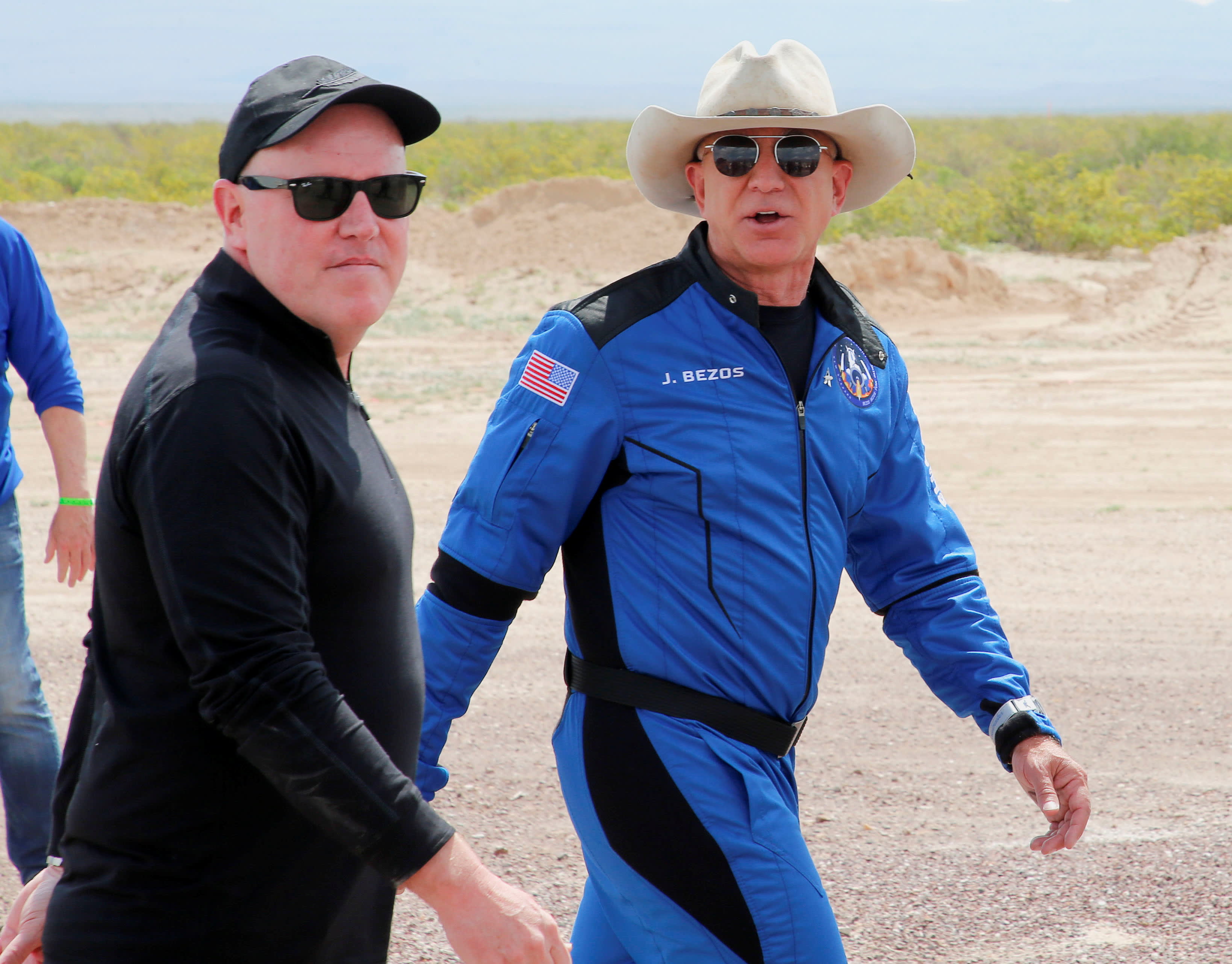Bezos’ Blue Origin calls Musk’s Starship ‘immensely complex & high risk’ for NASA moon missions

Billionaire American businessman Jeff Bezos walks with Blue Origin’s President and CEO Bob Smith after Bezos flew on the company’s inaugural flight to the edge of space, in the nearby town of Van Horn, Texas, U.S. July 20, 2021.
Joe Skipper | Reuters
Jeff Bezos’ space company remains on the offensive in criticizing NASA’s decision to award Elon Musk’s SpaceX with the sole contract to build a vehicle to land astronauts on the moon, despite the government last week denying Blue Origin’s protest.
In an infographic published on Blue Origin’s website and seen on Wednesday, the company called SpaceX using Starship to transport NASA astronauts to the lunar surface an “immensely complex & high risk” approach. Blue Origin is referring to a criticism that NASA officials made in evaluating Starship for the lunar lander program.
“There are an unprecedented number of technologies, developments, and operations that have never been done before for Starship to land on the Moon,” Blue Origin wrote.
Blue Origin
Last Friday, the U.S. Government Accountability Office denied Blue Origin’s protest of NASA awarding SpaceX with a $2.9 billion contract under the Human Landing System program. In three one-page documents, Blue Origin decried NASA’s decision as “wrong for America’s leadership in space” and repeated its prior critique that the space agency “ran an inconsistent and unfair competition” — even though the congressional watchdog ruled that NASA did not.
“NASA ran a flawed acquisition and ignored the significant risks of a one provider model,” Blue Origin wrote.
The company wants NASA to award a second contract under the original Human Landing System acquisition structure. While NASA has said it would offer future contracts under HLS through Lunar Exploration Transportation Services awards, those contracts are expected to be $45 million or less each.
Starship criticism
Starship prototype rocket SN15 launches from Boca Chica, Texas.
SpaceX
Starship prototype rocket SN15 touches down on the company’s landing pad on May 5, 2021, in Boca Chica, Texas.
SpaceX
Blue Origin made additional technical comparisons, noting that SpaceX’s plan requires more than 10 Starship launches to land once on the moon and needs to be refueled in orbit, “a process that has also never been done before.”
Lastly, Blue Origin compared the height of the astronaut exit hatches. Starship’s exit is 126 feet off the ground, and conceptually uses an elevator to bring astronauts to the surface, while the Blue Origin lander is 32 feet off the ground and requires crew drop down a long ladder.
One comparison that Blue Origin did not make was in regard to cost. NASA cited cost as a major factor in its decision to only select one winner under the Human Landing System, due to Congress granting the agency a fraction of its requested budget for the program. SpaceX bid $2.9 billion, while Blue Origin was roughly double at $5.99 billion.
In the first round of Human Landing System contracts, NASA handed out nearly $1 billion in concept development awards – with SpaceX receiving $135 million, Dynetics getting $253 million, and Blue Origin receiving $579 million.
Blue Origin’s lander
A mockup of the crew lander vehicle at NASA’s Johnson Space Center in August 2020.
Blue Origin
Bezos originally unveiled a lunar lander called Blue Moon in May 2019, before pivoting the next year to partner with Lockheed Martin, Northrop Grumman and Draper on a different concept for the Human Landing System. While the company has not tested any spacecraft in orbit, its partners have — a point Blue Origin emphasized by saying that its lunar lander “system is entirely built on heritage systems and proven technologies that are flying today.”
For its part, Blue Origin leverages the rocket engine and landing technologies its honed with its suborbital space tourism rocket New Shepard over the course of 16 flights.
Blue Origin also emphasized that its approach was simpler than SpaceX’s, as Bezos’ lander “only requires three launches” and has “far fewer in-space rendezvouses.”
Become a smarter investor with CNBC Pro.
Get stock picks, analyst calls, exclusive interviews and access to CNBC TV.
Sign up to start a free trial today.




